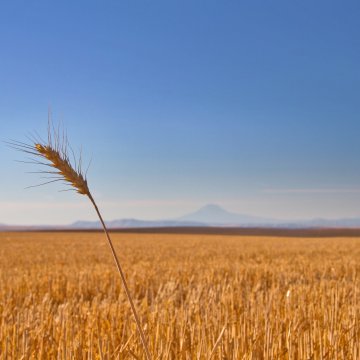
1. Wheat Futures Rise Overnight on Dry U.S., Russian Weather
Wheat futures surged in overnight trading as dry weather continues to threaten crops in the U.S. and abroad.
In the U.S., little to no rain has fallen in much of the southern Plains in the past 30 days, according to the National Weather Service precipitation page.
Southwestern Kansas and the Oklahoma and Texas panhandles haven’t seen any rain in at least the past month, NWS maps show.
Commodity Weather Group said in a report that the potential for any rainfall in the next two weeks “remains low … leaving nearly a third of (the) Wheat Belt at risk of germination problems.”
The U.S. winter-wheat crop was 52% planted as of last week, ahead of the prior five-year average of 52%, the Department of Agriculture said. The USDA will update its weekly crop progress report this afternoon, a day late due to Columbus Day.
Farmers have had to dust in wheat in some areas due to the lack of precipitation, and red-flag warnings have been issued in several producing areas due to high temperatures, low humidity, and strong winds that sap any moisture from the soil.
It’s also been dry in Russia, a major wheat grower, where chances of rain are “light” and “spotty” in growing areas for the next two weeks, Commodity Weather Group said. Some precipitation is expected in Ukraine, however, which may give crops there a boost.
Soybeans were higher in overnight trading on signs of strong demand for U.S. supplies and amid some dry weather in growing regions of South America.
Importers have committed to buy 40.7 million metric tons of U.S. beans since the start of the marketing year on Sept. 1. That’s up 151% from the same period last year.
Corn buyers have purchased 25.8 million metric tons of corn since the beginning of September, a 159% increase from the same time frame in 2019, the USDA said.
Wheat futures for December delivery added 7½¢ to $6.01¾ a bushel overnight on the Chicago Board of Trade, while Kansas City futures were up 6¼¢ to $5.36¾ a bushel.
Soybean futures for November delivery rose 5¢ to $10.38¾ a bushel. Soymeal gained 20¢ to $354.50 a short ton, and soy oil added 0.38¢ to 33.54¢ a pound.
Corn futures for December delivery rose 1½¢ to $3.90½ a bushel.
** **2. Chinese Bean Purchases in September Rise 19% Year-on-Year
The good news is that China is buying lots of soybeans. The bad news? Most of it is from Brazil.
China imported 9.8 million metric tons of soybeans last month, up 2% month-to-month and 19% from September 2019, Commerzbank said in a note to clients on Tuesday, citing Chinese customs data.
In the first nine months of the year, the Asian nation has imported 74.5 million tons of soybeans, a 16% increase from the same time frame a year earlier.
“Most of the shipments in September are still likely to have come from Brazil, as some could not be cleared by the customs authorities in the previous month,” Commerzbank analyst Carsten Fritsch said in the note. “Stocks in China have now apparently reached record level. Nonetheless, high imports can also be expected in the next few months, as China has placed substantial orders in the U.S. in recent weeks.”
The Chinese pig herd is recovering from African swine fever, boosting purchases of feed supplies.
The increase in demand from China pushed soybean futures to the highest level in more than two years before yesterday’s decline.
Dry weather in Brazil, the world’s biggest exporter of the oilseeds, has threatened the country’s crop and slowed planting, Fritsch said.
Rainfall yesterday, however, helped improve soil moisture, causing prices to fall in Monday trading, Fritsch said. The rainfall in the South American country is expected to continue, which could mean further pressure on soybean prices, he said.
**
3. Wildfire Risks Elevated in Northern Illinois While Strong Winds Forecast in South Dakota
The risk of wildfires is high in parts of northern Illinois today due to dry, windy conditions in the region, according to the National Weather Service.
“Southwest winds will increase across the area later this morning, and peak in intensity early this afternoon,” the NWS said in a report early this morning. “While much of the area will have a heightened threat for wild fires, it appears the areas roughly along and southeast of Interstate 55 will have the highest risk this afternoon.”
Winds are expected to slow later today, which will help reduce the risk of fires, the agency said.
In western South Dakota and northeastern Wyoming, meanwhile, a high-wind watch has been issued starting overnight into Wednesday.
Northwest sustained winds from 35 to 45 mph are forecast with gusts of up to 70 mph possible, the NWS said.
“The high winds could blow down large trees and damage roofs, small outbuildings, and signs,” the agency said. “Power outages are possible. Travel could be difficult, especially for high-profile vehicles.”








 User Center
User Center My Training Class
My Training Class Feedback
Feedback












Comments
Something to say?
Log in or Sign up for free